Desktop Input Methods
CDE provides the ability to enter localized input for an internationalized application that is using Xm Toolkit. The XmText[Field] widgets are enabled to interface with input methods from each locale. Input methods are internationalized because some language environments write their text from right-to-left, top-to-bottom, and so forth. Within the same application, you can use several fonts that apply different input methods.
The pre-edit area displays the string that is being pre-edited. This can be done in four modes:
-
OffTheSpot
-
OverTheSpot (default)
-
Root
-
None
Note -
In the Solaris 8 environment, there are native Asian input methods for Simplified/Traditional Chinese, Japanese, and Korean in addition to the current multi-script input methods for Unicode locales. This section includes descriptions of selected input methods, how to use them, and how to switch between them.
Script Selection and Input Modes
The en_US.UTF-8 locale supports multiple scripts. The en_US.UTF-8 locale has a total of twelve input modes:
-
English/European
-
Cyrillic
-
Greek
-
Arabic
-
Hebrew
-
Thai
-
Unicode Hexadecimal and Octal code input methods
-
Table lookup input method
-
Japanese
-
Korean
-
Simplified Chinese
-
Traditional Chinese
To switch into a certain input mode, you can either type in an input mode switch compose key sequence for each input mode, or press the left-most mouse button at the status area of your application to open an input mode selection window and select from the listed input modes as follows:
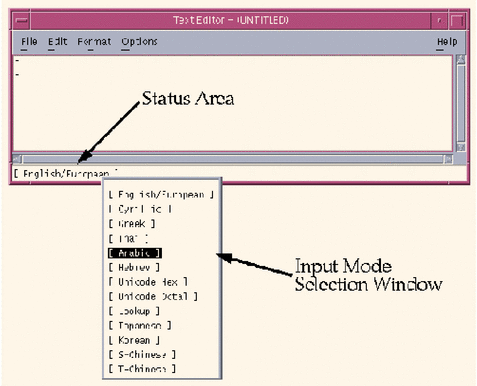
English/European Input Mode
The English/European input mode includes not only the English alphabet but also characters with diacritical marks (for example, á, è, î, õ, and ü) and special characters (such as ¡, §, ¿) from European scripts.
This input mode is the default mode for any application. The input mode is displayed at the bottom left corner of the GUI application.

To insert characters with diacritical marks or special characters from Latin-1, Latin-2, Latin-4, Latin-5, and Latin-9, you must type a Compose Sequence, as shown in the following examples:
-
For Ä, press and release Compose, then A, and then "
-
For ¿, press and release Compose, then ?, and then ?
When there is no <Compose> key available on your keyboard, you can substitute for the <Compose> key by simultaneously pressing the <Control> key, the <Shift> key and the <t> keys together.
For the input of the Euro currency symbol (Unicode value U+20AC) from the locale, you can use any one of following input sequences:
-
<AltGraph> and <e> together
-
<AltGraph> and <4> together
-
<AltGraph> and <5> together
These input sequences mean that you press both keys simultaneously. If there is no <AltGraph> key available on your keyboard, you can substitute the <Alt> key for the <AltGraph> key.
The following tables show the most commonly used Compose Sequences in Latin-1, Latin-2, Latin-4, Latin-5, and Latin-9 script input for the Solaris operating environment.
Note -
To start these sequences, press the <Compose> key and release it.
The following table lists the Common Latin-1 Compose Sequences.
Table 4-1 Common Latin-1 Compose Sequences|
Press and Release |
Press and Release |
Result |
|---|---|---|
|
[Spacebar] |
[Spacebar] |
No-break space |
|
s |
1 |
Superscripted 1 |
|
s |
2 |
Superscripted 2 |
|
s |
3 |
Superscripted 3 |
|
! |
! |
Inverted exclamation mark |
|
x |
o |
Currency symbol ¤ |
|
p |
! |
Paragraph symbol ¶ |
|
/ |
u |
mu u |
|
' |
" |
acute accent ´ |
|
, |
, |
cedilla Ç |
|
" |
" |
diaeresis ¨ |
|
- |
^ |
macron ¯ |
|
o |
o |
degree o |
|
x |
x |
multiplication sign x |
|
+ |
- |
plus-minus +- |
|
- |
- |
soft hyphen - |
|
- |
: |
division sign / |
|
- |
a |
ordinal (feminine) ª |
|
- |
o |
ordinal (masculine) º |
|
- |
, |
not sign ¬ |
|
. |
. |
middle dot · |
|
1 |
2 |
vulgar fraction ½ |
|
1 |
4 |
vulgar fraction ¼ |
|
3 |
4 |
vulgar fraction ¾ |
|
< |
< |
left double angle quotation mark « |
|
> |
> |
right double angle quotation mark » |
|
? |
? |
inverted question mark ¿ |
|
A |
` |
A grave À |
|
A |
' |
A acute Á |
|
A |
* |
A ring above Å |
|
A |
" |
A diaeresis Ä |
|
A |
^ |
A circumflex  |
|
A |
~ |
A tilde à |
|
A |
E |
AE diphthong Æ |
|
C |
, |
C cedilla Ç |
|
C |
o |
copyright sign © |
|
D |
- |
Capital eth ð |
|
E |
` |
E grave È |
|
E |
' |
E acute É |
|
E |
" |
E diaeresis Ë |
|
E |
^ |
E circumflex Ê |
|
I |
` |
I grave Ì |
|
I |
' |
I acute Í |
|
I |
" |
I diaeresis Ï |
|
I |
^ |
I circumflex Î |
|
L |
- |
pound sign £ |
|
N |
~ |
N tilde Ñ |
|
O |
` |
O grave Ò |
|
O |
' |
O acute Ó |
|
O |
/ |
O slash Ø |
|
O |
" |
O diaeresis Ö |
|
O |
^ |
O circumflex Ô |
|
O |
~ |
O tilde Õ |
|
R |
O |
registered mark \256 |
|
T |
H |
Thorn þ |
|
U |
` |
U grave Ù |
|
U |
' |
U acute Ú |
|
U |
" |
U diaeresis Ü |
|
U |
^ |
U circumflex Û |
|
Y |
' |
Y acute ý |
|
Y |
- |
yen sign ¥ |
|
a |
` |
a grave à |
|
a |
' |
a acute á |
|
a |
* |
a ring above å |
|
a |
" |
a diaeresis ä |
|
a |
~ |
a tilde ã |
|
a |
^ |
a circumflex â |
|
a |
e |
ae diphthong æ |
|
c |
, |
c cedilla ç |
|
c |
/ |
cent sign ¢ |
|
c |
o |
copyright sign © |
|
d |
- |
eth ð |
|
e |
` |
e grave è |
|
e |
' |
e acute é |
|
e |
" |
e diaeresis ë |
|
e |
^ |
e circumflex ê |
|
i |
` |
i grave ì |
|
i |
' |
i acute í |
|
i |
" |
i diaeresis ï |
|
i |
^ |
i circumflex î |
|
n |
~ |
n tilde ñ |
|
o |
` |
o grave ò |
|
o |
' |
o acute ó |
|
o |
/ |
o slash ø |
|
o |
" |
o diaeresis ö |
|
o |
^ |
o circumflex ô |
|
o |
~ |
o tilde õ |
|
s |
s |
German double s ß |
|
t |
h |
thorn þ |
|
u |
` |
u grave ù |
|
u |
' |
u acute ú |
|
u |
" |
u diaeresis ü |
|
u |
^ |
u circumflex û |
|
y |
' |
y acute y |
|
y |
" |
y diaeresis ÿ |
|
| |
| |
The following table lists the Common Latin-2 and Latin-4 Compose Sequences.
Table 4-2 Common Latin-2 Compose Sequences|
Press and Release |
Press and Release |
Result |
|---|---|---|
|
a |
' ' |
ogonek |
|
u |
' ' |
breve |
|
v |
' ' |
caron |
|
" |
' ' |
double acute |
|
A |
a |
A ogonek |
|
A |
u |
A breve |
|
C |
' |
C acute |
|
C |
v |
C caron |
|
D |
v |
D caron |
|
- |
D |
D stroke |
|
E |
v |
E caron |
|
E |
a |
E ogonek |
|
L |
' |
L acute |
|
L |
- |
L stroke |
|
L |
> |
L caron |
|
N |
' |
N acute |
|
N |
v |
N caron |
|
O |
> |
O double acute |
|
S |
' |
S acute |
|
S |
v |
S caron |
|
S |
, |
S cedilla |
|
R |
' |
R acute |
|
R |
v |
R caron |
|
T |
v |
T caron |
|
T |
, |
T cedilla |
|
U |
* |
U ring above |
|
U |
> |
U double acute |
|
Z |
' |
Z acute |
|
Z |
v |
Z caron |
|
Z |
. |
Z dot above |
|
k |
k |
kra |
|
A |
_ |
A macron |
|
E |
_ |
E macron |
|
E |
. |
E dot above |
|
G |
, |
G cedilla |
|
I |
_ |
I macron |
|
I |
~ |
I tilde |
|
I |
a |
I ogonek |
|
K |
, |
K cedilla |
|
L |
, |
L cedilla |
|
N |
, |
N cedilla |
|
O |
_ |
O macron |
|
R |
, |
R cedilla |
|
T |
| |
T stroke |
|
U |
~ |
U tilde |
|
U |
a |
U ogonek |
|
U |
_ |
U macron |
|
N |
N |
Eng |
|
a |
_ |
a macron |
|
e |
_ |
e macron |
|
e |
. |
e dot above |
|
g |
, |
g cedilla |
|
i |
_ |
i macron |
|
i |
~ |
i tilde |
|
i |
a |
i ogonek |
|
k |
, |
k cedilla |
|
l |
, |
l cedilla |
|
n |
, |
n cedilla |
|
o |
_ |
o macron |
|
r |
, |
r cedilla |
|
t |
| |
t stroke |
|
u |
~ |
u tilde |
|
u |
a |
u ogonek |
|
u |
_ |
u macron |
|
n |
n | |
The following table lists the Common Latin-5 Compose Sequences.
Table 4-3 Common Latin-5 Compose Sequences|
Press and Release |
Press and Release |
Result |
|---|---|---|
|
G |
u |
G breve |
|
I |
. |
I dot above |
|
g |
u |
g breve |
|
i |
. |
Any Compose Sequences already described do not re-appear in this table.
The following table lists the Common Latin-9 Compose Sequences.
Table 4-4 Common Latin-9 Compose Sequences|
Press and Release |
Press and Release |
Result |
|---|---|---|
|
o |
e |
Diphthong oe |
|
O |
E |
Diphthong OE |
|
Y |
" |
Y diaeresis |
Cyrillic Input Mode
To switch to Cyrillic input mode, either press <Compose> <c> <c> at your keyboard, or press the left-most mouse button at the status area of your application and select "[Cyrillic]" from the Input Mode Selection Window.
The input mode is displayed at the bottom left corner of your GUI application.

After you switch to Cyrillic input mode, you cannot enter English or European text. To switch back to the English/European input mode, type <Control> + <Space> from your keyboard, or select "[English/European]" input mode from the Input Mode Selection Window by using your mouse. The Russian keyboard layout appears in the following figure.
Figure 4-1 Cyrillic Keyboard
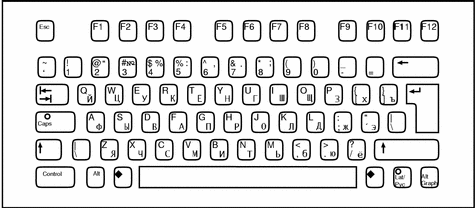
You can also switch into other input modes by typing the corresponding input mode switch key sequence.
Greek Input Mode
To switch to Greek input mode, either press Compose <g> <g> at your keyboard, or press the left-most mouse button at the status area of your application and select "[Greek]", from the Input Mode Selection Window.
The input mode is displayed at the left bottom corner of your GUI application.

After you switch to Greek input mode, you cannot enter English or European text. To switch back to the English/European input mode, type <Control> + <Space> from your keyboard, or select "[English/European]" input mode from the Input Mode Selection Window by using your mouse. The Greek keyboard layouts appear in the following two figures.
Figure 4-2 Greek Euro Keyboard
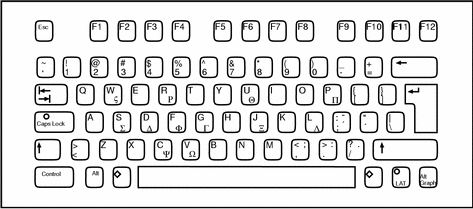
Figure 4-3 Greek UNIX Keyboard

Arabic Input Mode
To switch to Arabic input mode, type <Compose> <a> <r> from your current input mode. The input mode is displayed at the left bottom corner of your GUI application. After you switch to the Arabic input mode, you have to switch back to English/European input mode to enter English/European characters by typing <Control> and <Space> together.
You can also switch into other input modes by either typing the corresponding input mode switch key sequence from your keyboard, or selecting an input mode from the Input Mode Selection Window by using y our mouse.

Figure 4-4 Arabic Keyboard

Hebrew Input Mode
To switch into Hebrew input mode, type <Compose> <h> <h> from your current input mode. The input mode is displayed at the bottom left corner of your GUI application. You can also switch into the Hebrew input mode by pressing the left-most mouse button at the status area of your application and then selecting "[Hebrew]" from the Input Mode Selection Window.
After you have switched into the Hebrew input mode, you have to switch back to the English/European input mode to enter English/European characters. To switch your input mode, you can either type the corresponding input mode switch key sequence of your next input mode from your keyboard, or select an input mode from the Input Mode Selection Window by using your mouse. The Hebrew keyboard layout is shown in the following figure:

Figure 4-5 Hebrew Keyboard
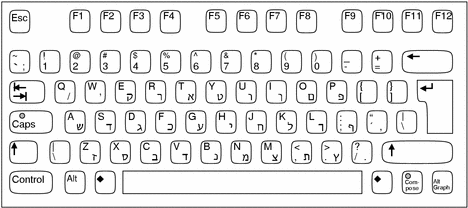
Thai Input Mode
To switch into Thai input mode, type <Compose> <t> <t> from your current input mode. The input mode displays at the left bottom corner of your GUI application.

After you have switched into the Thai input mode, you have to switch back to English/European input mode to enter English/European characters. To switch your input mode, either type the corresponding input mode switch key sequence of your next input mode from your keyboard, or select an input mode from the Input Mode Selection Window by using your mouse. The Thai keyboard layout is shown in the following figure:
Figure 4-6 Thai Keyboard

Unicode Hexadecimal and Octal Code Input Method Input Modes
To switch into the Unicode hexadecimal code input method input mode, type <Compose> <u> <h> from your current input mode. You can also select "[Unicode Hex]" from the Input Mode Selection Window by using your mouse. The input mode is displayed at the left bottom corner of your application.
If you prefer the octal number system, you can also switch into the Unicode octal code input method input mode by typing <Compose> <u> <o> from your current input mode or by selecting "[Unicode Octal]" from the Input Mode Selection Window
To use these input mode, you need to know about either the hexadecimal or the octal code point values of the characters. Refer to The Unicode Standard, Version 3.0 for the mapping between code point values and characters. To input a character, type four hexadecimal digits if you are in the Unicode hexadecimal code input method input mode, for instance, 00a1 for Inverted Exclamation Mark, 03b2 for Greek Small Letter Beta, ac00 for a Korean Hangul Syllable KA, 30a2 for Japanese Katakana Letter A, 4e58 for a Unified Han character, and so on. Users can use both uppercase and lowercase letters of A, B, C, D, E, and, F for hexadecimal digits. If you prefer the octal number system instead of hexadecimal numbers, you can input octal digits, 0 to 7. If you mistype a digit or two, you can delete the digits by using the <Delete> key or the <Backspace> key.


Table Lookup Input Method Input Mode
To switch into table lookup input method input mode, type <Compose> <l> <l> from your current input mode. The input mode is displayed at the bottom left corner of your GUI application.

After you turn on the input mode, there is a lookup group window showing multiple groups of characters. You can choose any one of the groups to enter characters from the group. Once you select a group, there will be the second lookup window showing multiple candidates of available Unicode characters belonging to the group of your choice. You can choose any one of the candidates by moving your pointer and clicking the left button on your mouse. You can also select any one of the candidates by choosing a left-hand-side letter associated with each of the candidates.
You can also see the next set of candidates by typing <Control> and <n> keys together. Similarly, to see the previous set of candidates, type the <Control> and <p> keys together. The <n> stands for 'next' and the <p> stands for 'previous'.
After you are finished using the current input mode, you can switch into another input mode by typing a corresponding input mode switch key sequence.
Japanese Input Mode
To switch into the Japanese input mode, type either <Compose> <j> <a> from your keyboard or select "[ Japanese ]" from the Input Mode Selection Window by using your mouse. The input mode is displayed at the left bottom corner of your application. The following figure shows a Japanese input method mode of ATOK12:

To use the native Japanese input system, you need to install one or more of Japanese locales on your system. Once you install the Japanese locales, you will be able to use any one of native Japanese input systems like ATOK12, ATOK8, Wnn6, or cs00.
For more details on how to use the Japanese Input System, refer to "ATOK12 User's Guide", "ATOK8 User's Guide", "Wnn6 User's Guide", and, "cs00 User's Guide."
Korean Input Mode
To switch into the Korean input mode, type either <Compose> <k> <o>from your keyboard, or select "[ Korean ]" from the Input Mode Selection Window by using your mouse. The input mode is displayed at the left bottom corner of your application. The following figure shows Phonetic Hangul input method which is one of many native Korean input methods available.
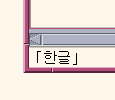
To have the native Korean input system, you need to install one or more Korean locale on your system. Once you install the Korean locale, you will be able to use the native Korean input system. For more details on how to use the Korean Input System, refer to "Korean Solaris User's Guide".
Simplified Chinese Input Mode
To switch input Simplified Chinese input mode, type either <Compose> <s> <c> from your keyboard, or select "[ S-Chinese ]" from the Input Mode Selection Window by using your mouse. The input mode is displayed at the left bottom corner of your application. The following figure shows New Pin Yin input method which is one of many native Simplified Chinese input methods available.

To use the native Simplified Chinese input system, you need to install one or more Simplified Chinese locales on your system. Once you install the Simplified Chinese locales, you will be able to use the native Simplified Chinese input system. For more details on how to use Simplified Chinese Input System, refer to "Simplified Chinese Solaris User's Guide."
Traditional Chinese Input Mode
To switch input Traditional Chinese input mode, type either <Compose> <t> <c> from your keyboard or select "[ T-Chinese ]" from the Input Mode Selection Window by using your mouse. The input mode is displayed at the left bottom corner of your application. The following figure shows the TsangChieh input method which is one of many native Traditional Chinese input methods available.

To have the native Traditional Chinese input system, you need to install one or more of Traditional Chinese locales at your system. Once you install the Traditional Chinese locales, you will be able to use the native Traditional Chinese input system. For more details on how to use the Traditional Chinese Input System, refer to "Traditional Chinese Solaris User's Guide".
Input Mode Switch Key Sequence Summary
Users can switch from one input mode to another without any restrictions. The following table shows the input mode switch key sequences for each input mode.
Table 4-5 Input Mode Switch Key Sequences| Input Mode | Key Sequences |
|---|---|
| English/European | <Control> + <Space> |
| Cyrillic | <Compose> <c> <c> |
| Greek | <Compose> <g> <g> |
| Arabic | <Compose> <a> <r> |
| Hebrew | <Compose> <h> <h> |
| Thai | <Compose> <t> <t> |
| Unicode hexadecimal code input method | <Compose> <u> <h> |
| Table lookup input method | <Compose> <l> <l> |
| Unicode octal code input method | <Compose> <u> <o> |
| Japanese | <Compose> <j> <a> |
| Korean | <Compose> <k> <o> |
| Simplified Chinese | <Compose> <s> <c> |
| Traditional Chinese | <Compose> <t> <c> |
- © 2010, Oracle Corporation and/or its affiliates
